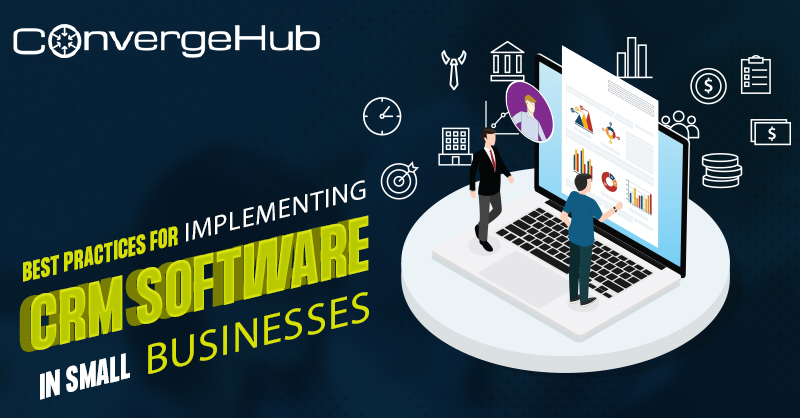
Implementing a CRM system is a crucial step in enhancing customer interactions, streamlining business operations, and driving growth, but its success depends on careful planning, preparation, and execution. This guide will walk you through the CRM implementation process, outlining key steps, best practices, and a clear roadmap to ensure a smooth transition. Whether you’re a small startup or an established enterprise, you’ll gain valuable insights to confidently integrate CRM into your workflow and maximize its impact.
Optimizing Business Efficiency with CRM Integration
Implementing a CRM system isn’t just about integrating new software—it’s a strategic approach to strengthening customer relationships, optimizing workflows, and making smarter, data-driven decisions. A well-executed CRM implementation enables businesses to centralize customer information, automate repetitive tasks, and improve communication, resulting in enhanced customer experiences and greater operational efficiency.
CRM Best Practices: Maximizing Profitability & Efficiency
CRM practices encompass a strategic approach to adopting and utilizing a CRM tool to enhance profitability and streamline business operations. While many companies invest in CRM systems, only a few prioritize effective implementation—often resulting in little to no impact on their bottom line.
To unlock the full potential of a CRM solution, businesses should focus on proven strategies such as dedicating sufficient time to implementation and employee training, selecting a CRM vendor with reliable support and onboarding assistance, conducting a thorough requirement analysis before choosing a solution, and leveraging automation capabilities for efficiency.
Beyond these essentials, crafting a well-defined CRM strategy ensures businesses maximize their CRM investment, improving customer relationships and driving growth.
Why Investing in a Reliable CRM Solution Matters
Before exploring the best CRM systems and practices, it’s essential to understand the value of a reliable CRM tool. A scalable and adaptable CRM system sets the foundation for long-term success, ensuring seamless integration into your business strategy.
Here’s how the right CRM solution can transform your operations:
With over 47% of businesses seeing improved customer retention and 74% benefiting from better data access, investing in a quality CRM is a strategic move toward sustainable growth.
Key Considerations When Selecting a CRM System & Strategy
Choosing the right CRM solution and developing a strategy for its implementation requires careful planning and research. Businesses must assess their specific needs, conduct market analysis, and identify a CRM tool that aligns with their long-term goals.
By considering these factors, businesses can implement a CRM strategy that drives efficiency, improves collaboration, and maximizes customer relationships.
CRM Implementation: A Step-by-Step Guide
Step 1: Define Clear Goals and Objectives
Before integrating a CRM system, establish specific goals that align with your business needs—whether it’s enhancing customer satisfaction, boosting sales, or streamlining marketing campaigns. A well-defined strategy ensures that your CRM implementation drives measurable results.
Step 2: Choose the Right CRM Solution
Selecting the ideal CRM software is pivotal to long-term success. Assess various providers based on scalability, budget, and essential features like contact management, lead tracking, and analytics. Choose a CRM that aligns with your industry and operational needs for maximum efficiency.
Step 3: Execute a Strategic Data Migration
Migrating customer data into your CRM system demands careful planning. Cleanse and organize existing data to maintain accuracy and consistency. Develop a migration strategy that includes data mapping, integrity testing, and phased implementation to minimize disruptions.
Step 4: Customize and Configure the CRM
Tailor the CRM system to fit your business processes. Configure workflows, automation rules, and field structures to align with your sales funnel, customer segments, and unique terminology. A well-optimized CRM ensures seamless integration into daily operations.
Step 5: Train and Engage Users for Success
A CRM is only as effective as its users. Conduct comprehensive training sessions to familiarize your team with its functionalities. Encourage adoption through active participation, address concerns, and foster a culture of continuous learning to unlock the full potential of CRM.
Key Strategies for a Successful CRM Implementation
Unlock Business Growth with Strategic CRM Implementation
Implementing a CRM system is more than just adopting new technology—it’s a transformative process that strengthens customer relationships, enhances efficiency, and drives sustainable business growth. By following best practices and a well-defined roadmap, businesses can streamline operations, boost engagement, and maximize profitability.
Success with CRM isn’t just about software—it’s about cultivating a customer-centric mindset and empowering your team to leverage its full potential. Whether you’re a small business focused on personalized interactions or a large enterprise optimizing sales and marketing strategies, CRM implementation can be a powerful catalyst for success.
Take the first step today, embrace the possibilities of CRM, and position your business for long-term growth. Let me know if you’d like any refinements!